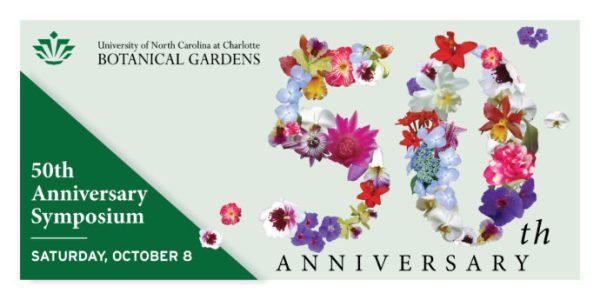UNC Charlotte Botanical Gardens Celebrate 50 Years With Symposium

Gain an intoxicating perspective on the leaves, bark, seeds, roots, flowers and fruit imbibed around the world when Amy Stewart, best-selling author of The Drunken Botanist: The Plants  That Create the World’s Great Drinks, keynotes a UNC Charlotte Botanical Gardens’ 50th Anniversary Symposium on Saturday, October 8, 2016.
That Create the World’s Great Drinks, keynotes a UNC Charlotte Botanical Gardens’ 50th Anniversary Symposium on Saturday, October 8, 2016.
Attendees also will learn easy-to- remember garden design strategies for working with such elements as form, texture and color, during a talk by Steve Aitken, editor of Fine Gardening magazine. This symposium also features a look back at the gardens’ history as well as a peek at what is coming next. Lunch and a tour of the Gardens are included.
Doors will open at 8:30 a.m. on the third floor of the Student Union on the UNC Charlotte main campus. Complimentary parking will be available in the Student Union parking deck. Participants will tour the Gardens from 3 p.m. to 4 p.m. Walking shoes are encouraged.
The symposiu m is open to the public; pre-registration is required. Register online or call 704-687- 0721 by August 31 to receive the “Early Bird” discount rate for the daylong event. Registration will close October 3.
m is open to the public; pre-registration is required. Register online or call 704-687- 0721 by August 31 to receive the “Early Bird” discount rate for the daylong event. Registration will close October 3.
Begun in 1966 on the newly-established Charlotte campus of the University of North Carolina system, the Botanical Gardens were the brainchild of biology professor Herbert Hechenbleikner and UNC Charlotte founder Bonnie E. Cone. The gardens serve as a living classroom for biology students and as a horticultural and botanical resource for the campus and greater community.
As landscape manager, Hechenbleikner began growing unusual native plants on UNC Charlotte’s young but growing campus; this led to the development of the Van Landingham Glen, a seven-acre garden of hybrid rhododendrons and native plants of the Carolinas. Today, the Botanical Gardens include 10 acres of outdoor gardens, a 4,500-square- foot glasshouse with attached workspace, and a classroom that also contains a botanical and horticultural library of more than 1,200 books. More information can be found on the gardens’ website.